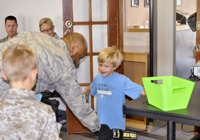
Similar to a commercial aircraft
· Passengers are subject to all TSA regulations, such as limits on liquids and gels
· Prior to boarding, passengers will walk through a metal detector and their luggage will be screened
· Arrival 2-3 hours in advance of the departure time is recommended
· Aircrew members will give you a safety briefing and demonstrate the use of oxygen in case of a loss of pressure
· There are limitations to carry on and checked luggage that should be reviewed in advance
 Different than a commercial aircraft
Different than a commercial aircraft
· Don't expect the loadmasters to bring you soft drinks or play movies on the flight
· The aircraft will be noisier, colder and have more vibration
· Often, you will be sitting on a "jump seat" made of nylon webbing and you will be oriented sideways instead of facing front
· You cannot bring your pet animals on the plane
· Depending on the type of aircraft, the space could be tight and dark.
· The latrine will be smaller and more primitive
· No open-toed or high heeled shoes are allowed
· Once in flight, you do not have to stay in your seat. You can walk around, find a window to look out, and if you've brought a sleeping bag and pad, you can roll it out on the floor and take a nap
· You could have the opportunity to see an Air Force aerial evolution up close, like a refueling mission
· Also riding with you in the aircraft could be humvees, military police dogs, a helicopter, a tank, generators or pallets of equipment or weapons
· You may be permitted to view the cockpit and watch the pilots in action during the flight